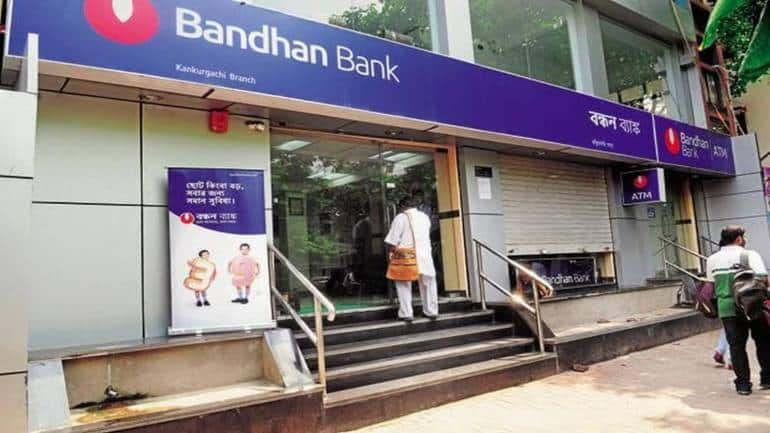MC Explains | Bandhan Bank’s loans worth Rs 23,300 crore are being probed. Here’s why


The bank’s portfolio of loans under the government’s credit guarantee schemes is being reviewed to find window-dressing or evergreening
.
‘);
$(‘#lastUpdated_’+articleId).text(resData[stkKey][‘lastupdate’]);
//if(resData[stkKey][‘percentchange’] > 0){
// $(‘#greentxt_’+articleId).removeClass(“redtxt”).addClass(“greentxt”);
// $(‘.arw_red’).removeClass(“arw_red”).addClass(“arw_green”);
//}else if(resData[stkKey][‘percentchange’] < 0){
// $(‘#greentxt_’+articleId).removeClass(“greentxt”).addClass(“redtxt”);
// $(‘.arw_green’).removeClass(“arw_green”).addClass(“arw_red”);
//}
if(resData[stkKey][‘percentchange’] >= 0){
$(‘#greentxt_’+articleId).removeClass(“redtxt”).addClass(“greentxt”);
//$(‘.arw_red’).removeClass(“arw_red”).addClass(“arw_green”);
$(‘#gainlosstxt_’+articleId).find(“.arw_red”).removeClass(“arw_red”).addClass(“arw_green”);
}else if(resData[stkKey][‘percentchange’] < 0){
$(‘#greentxt_’+articleId).removeClass(“greentxt”).addClass(“redtxt”);
//$(‘.arw_green’).removeClass(“arw_green”).addClass(“arw_red”);
$(‘#gainlosstxt_’+articleId).find(‘.arw_green’).removeClass(“arw_green”).addClass(“arw_red”);
}
$(‘#volumetxt_’+articleId).show();
$(‘#vlmtxt_’+articleId).show();
$(‘#stkvol_’+articleId).text(resData[stkKey][‘volume’]);
$(‘#td-low_’+articleId).text(resData[stkKey][‘daylow’]);
$(‘#td-high_’+articleId).text(resData[stkKey][‘dayhigh’]);
$(‘#rightcol_’+articleId).show();
}else{
$(‘#volumetxt_’+articleId).hide();
$(‘#vlmtxt_’+articleId).hide();
$(‘#stkvol_’+articleId).text(”);
$(‘#td-low_’+articleId).text(”);
$(‘#td-high_’+articleId).text(”);
$(‘#rightcol_’+articleId).hide();
}
$(‘#stk-graph_’+articleId).attr(‘src’,’//appfeeds.moneycontrol.com/jsonapi/stocks/graph&format=json&watch_app=true&range=1d&type=area&ex=’+stockType+’&sc_id=’+stockId+’&width=157&height=100&source=web’);
}
}
}
});
}
$(‘.bseliveselectbox’).click(function(){
$(‘.bselivelist’).show();
});
function bindClicksForDropdown(articleId){
$(‘ul#stockwidgettabs_’+articleId+’ li’).click(function(){
stkId = jQuery.trim($(this).find(‘a’).attr(‘stkid’));
$(‘ul#stockwidgettabs_’+articleId+’ li’).find(‘a’).removeClass(‘active’);
$(this).find(‘a’).addClass(‘active’);
stockWidget(‘N’,stkId,articleId);
});
$(‘#stk-b-‘+articleId).click(function(){
stkId = jQuery.trim($(this).attr(‘stkId’));
stockWidget(‘B’,stkId,articleId);
$(‘.bselivelist’).hide();
});
$(‘#stk-n-‘+articleId).click(function(){
stkId = jQuery.trim($(this).attr(‘stkId’));
stockWidget(‘N’,stkId,articleId);
$(‘.bselivelist’).hide();
});
}
$(“.bselivelist”).focusout(function(){
$(“.bselivelist”).hide(); //hide the results
});
function bindMenuClicks(articleId){
$(‘#watchlist-‘+articleId).click(function(){
var stkId = $(this).attr(‘stkId’);
overlayPopupWatchlist(0,2,1,stkId);
});
$(‘#portfolio-‘+articleId).click(function(){
var dispId = $(this).attr(‘dispId’);
pcSavePort(0,1,dispId);
});
}
$(‘.mc-modal-close’).on(‘click’,function(){
$(‘.mc-modal-wrap’).css(‘display’,’none’);
$(‘.mc-modal’).removeClass(‘success’);
$(‘.mc-modal’).removeClass(‘error’);
});
function overlayPopupWatchlist(e, t, n,stkId) {
$(‘.srch_bx’).css(‘z-index’,’999′);
typparam1 = n;
if(readCookie(‘nnmc’))
{
var lastRsrs =new Array();
lastRsrs[e]= stkId;
if(lastRsrs.length > 0)
{
var resStr=”;
let secglbVar = 1;
var url = ‘//www.moneycontrol.com/mccode/common/saveWatchlist.php’;
$.get( “//www.moneycontrol.com/mccode/common/rhsdata.html”, function( data ) {
$(‘#backInner1_rhsPop’).html(data);
$.ajax({url:url,
type:”POST”,
dataType:”json”,
data:{q_f:typparam1,wSec:secglbVar,wArray:lastRsrs},
success:function(d)
{
if(typparam1==’1′) // rhs
{
var appndStr=”;
//var newappndStr = makeMiddleRDivNew(d);
//appndStr = newappndStr[0];
var titStr=”;var editw=”;
var typevar=”;
var pparr= new Array(‘Monitoring your investments regularly is important.’,’Add your transaction details to monitor your stock`s performance.’,’You can also track your Transaction History and Capital Gains.’);
var phead =’Why add to Portfolio?’;
if(secglbVar ==1)
{
var stkdtxt=’this stock’;
var fltxt=’ it ‘;
typevar =’Stock ‘;
if(lastRsrs.length>1){
stkdtxt=’these stocks’;
typevar =’Stocks ‘;fltxt=’ them ‘;
}
}
//var popretStr =lvPOPRHS(phead,pparr);
//$(‘#poprhsAdd’).html(popretStr);
//$(‘.btmbgnwr’).show();
var tickTxt =’‘;
if(typparam1==1)
{
var modalContent = ‘Watchlist has been updated successfully.’;
var modalStatus = ‘success’; //if error, use ‘error’
$(‘.mc-modal-content’).text(modalContent);
$(‘.mc-modal-wrap’).css(‘display’,’flex’);
$(‘.mc-modal’).addClass(modalStatus);
//var existsFlag=$.inArray(‘added’,newappndStr[1]);
//$(‘#toptitleTXT’).html(tickTxt+typevar+’ to your watchlist’);
//if(existsFlag == -1)
//{
// if(lastRsrs.length > 1)
// $(‘#toptitleTXT’).html(tickTxt+typevar+’already exist in your watchlist’);
// else
// $(‘#toptitleTXT’).html(tickTxt+typevar+’already exists in your watchlist’);
//
//}
}
//$(‘.accdiv’).html(”);
//$(‘.accdiv’).html(appndStr);
}
},
//complete:function(d){
// if(typparam1==1)
// {
// watchlist_popup(‘open’);
// }
//}
});
});
}
else
{
var disNam =’stock’;
if($(‘#impact_option’).html()==’STOCKS’)
disNam =’stock’;
if($(‘#impact_option’).html()==’MUTUAL FUNDS’)
disNam =’mutual fund’;
if($(‘#impact_option’).html()==’COMMODITIES’)
disNam =’commodity’;
alert(‘Please select at least one ‘+disNam);
}
}
else
{
AFTERLOGINCALLBACK = ‘overlayPopup(‘+e+’, ‘+t+’, ‘+n+’)’;
commonPopRHS();
/*work_div = 1;
typparam = t;
typparam1 = n;
check_login_pop(1)*/
}
}
function pcSavePort(param,call_pg,dispId)
{
var adtxt=”;
if(readCookie(‘nnmc’)){
if(call_pg == “2”)
{
pass_sec = 2;
}
else
{
pass_sec = 1;
}
var postfolio_url = ‘https://www.moneycontrol.com/portfolio_new/add_stocks_multi.php?id=’+dispId;
window.open(postfolio_url, ‘_blank’);
} else
{
AFTERLOGINCALLBACK = ‘pcSavePort(‘+param+’, ‘+call_pg+’, ‘+dispId+’)’;
commonPopRHS();
/*work_div = 1;
typparam = t;
typparam1 = n;
check_login_pop(1)*/
}
}
function commonPopRHS(e) {
/*var t = ($(window).height() – $(“#” + e).height()) / 2 + $(window).scrollTop();
var n = ($(window).width() – $(“#” + e).width()) / 2 + $(window).scrollLeft();
$(“#” + e).css({
position: “absolute”,
top: t,
left: n
});
$(“#lightbox_cb,#” + e).fadeIn(300);
$(“#lightbox_cb”).remove();
$(“body”).append(”);
$(“#lightbox_cb”).css({
filter: “alpha(opacity=80)”
}).fadeIn()*/
$(“.linkSignUp”).click();
}
function overlay(n)
{
document.getElementById(‘back’).style.width = document.body.clientWidth + “px”;
document.getElementById(‘back’).style.height = document.body.clientHeight +”px”;
document.getElementById(‘back’).style.display = ‘block’;
jQuery.fn.center = function () {
this.css(“position”,”absolute”);
var topPos = ($(window).height() – this.height() ) / 2;
this.css(“top”, -topPos).show().animate({‘top’:topPos},300);
this.css(“left”, ( $(window).width() – this.width() ) / 2);
return this;
}
setTimeout(function(){$(‘#backInner’+n).center()},100);
}
function closeoverlay(n){
document.getElementById(‘back’).style.display = ‘none’;
document.getElementById(‘backInner’+n).style.display = ‘none’;
}
stk_str=”;
stk.forEach(function (stkData,index){
if(index==0){
stk_str+=stkData.stockId.trim();
}else{
stk_str+=’,’+stkData.stockId.trim();
}
});
$.get(‘//www.moneycontrol.com/techmvc/mc_apis/stock_details/?classic=true&sc_id=’+stk_str, function(data) {
stk.forEach(function (stkData,index){
$(‘#stock-name-‘+stkData.stockId.trim()+’-‘+article_id).text(data[stkData.stockId.trim()][‘nse’][‘shortname’]);
});
});
function redirectToTradeOpenDematAccountOnline(){
if (stock_isinid && stock_tradeType) {
window.open(`https://www.moneycontrol.com/open-demat-account-online?classic=true&script_id=${stock_isinid}&ex=${stock_tradeType}&site=web&asset_class=stock&utm_source=moneycontrol&utm_medium=articlepage&utm_campaign=tradenow&utm_content=webbutton`, ‘_blank’);
}
}
The National Credit Guarantee Trustee Company (NCGTC) is conducting a forensic audit on about Rs 23,300 crore of loans disbursed by Bandhan Bank under the government’s credit guarantee schemes.
The NCGTC has flagged that the loans were either evergreened or that Bandhan Bank created fictitious accounts to obtain the maximum guarantee cover. A document accessed by Moneycontrol shows the auditor will perform data analytics on the portfolio to identify evergreening of loans
What does this mean? Why does the NCGTC want to audit these loans? What is the bank saying? Read on to find out:
What is a forensic audit?
A forensic audit is an examination and evaluation of a company’s financial information to extract facts.
What is the size of the loans that NCGTC wants audited?
The loans are under two categories of guarantee schemes known as CGFMU and ECLGS.
CGFMU – Loans amounting to about Rs 20,800 crore in respect of around 29
lakh borrowers under the Credit Guarantee Fund for Micro Units. In this category, micro and small enterprises can avail of collateral-free credit.
Story continues below Advertisement
ECLGS – Loans amounting to about Rs 2,500 crore in respect of around 22 lakh borrowers under the Emergency Credit Line Guarantee Scheme (ECLGS) announced as part of the Aatmanirbhar Bharat Package in 2020, during the COVID-19 crisis.
Also Read: Bandhan Bank slumps over 7% as weak asset quality in Q3 upsets Street; release of govt claims eyed
If a borrower defaults on these loans, is the bank guaranteed a cover against the loss?
Yes, but not on the entire amount. In case of CGFMU, the total claim payout ratio is capped at 15 percent of the original sanctioned amount. This means the bank can claim a maximum of Rs 3,100 crore (15 percent of Rs 20,800 crore).
For ECLGS, there is 100 percent guarantee against any loss.
Have all accounts under these two schemes been classified as non-performing assets?
No. About 5.5 lakh borrowers of loans amounting to Rs 4,000 crore have been classified as NPAs under CGFMU.
Under ECLGS, about 7.55 lakh borrowers for an amount of Rs 955 crore have been classified as NPAs.
Loans turn into NPAs when payments are overdue for 90 days.
Why does the NCGTC want the entire portfolio to be audited?
The NCGTC suspects that Bandhan Bank created fictitious accounts to apply under both CGFMU and ECLGS schemes in order to get the maximum guarantee cover. It also fears that some loans under the CGFMU scheme were evergreened.
Evergreening is the practice of extending new or additional loans to a borrower unable to repay existing loans, thereby concealing the true status of an NPA or bad loan.
Where are these borrowers concentrated?
Bandhan Bank has its headquarters at Kolkata. Most of the lending is in West Bengal, Assam and Odisha, the NCGTC said.
What is the bank saying?
The bank said on it earnings call that the outstanding portfolio eligible for insurance was Rs 20,800 crore under CGFMU and Rs 2,000 crore under ECLGS.
It said 85 percent of this portfolio was repaid by borrowers and Rs 3,600 crore was under stress, for which claims were initiated.
“The bank has been carrying an outstanding provision of ~90 percent on these stressed loans,” the management said.
Also Read: Bandhan Bank Q3 profit jumps over two-fold to Rs 733 crore
The total claims made by the bank were Rs 2,200 crore. Bandhan Bank already has received Rs 920 crore under tranche I (of which Rs 220 crore has to be repaid because borrowers turned in payments later).
The bank has filed claims of Rs 1,300 crore in Tranche 2 and is looking to recover the amount once NCGTC’s audit has been completed.
How long will the audit take?
The audit is expected to take about 90 days.
How did the bank fare in the December quarter?
Bandhan Bank’s net NPA rose to 2.2 percent in Q3 of FY24 from 1.9 percent a year earlier. If the NCGTC’s claims are correct, its NPAs could be much higher. Net profit increased over twofold to Rs 733 crore.







:max_bytes(150000):strip_icc():format(jpeg)/GettyImages-1296348323-44c7aca2cbb14d2f84b65b393fec649a.jpg)
:max_bytes(150000):strip_icc():format(jpeg)/GettyImages-171349083-062edb8f4c13435797d038746c27422f.jpg)
:max_bytes(150000):strip_icc():format(jpeg)/GettyImages-21669937071-728bfabe684b4c8aa17fc9c47255a740.jpg)